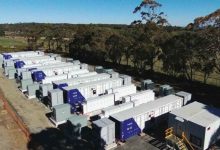The Victoria Labor government has officially unveiled the Ballarat Energy Storage System, the first of two big batteries that will support Victoria’s energy grid from the start of this summer.
The 30MW/30MWh facility at the Ballarat terminal station will be operated by EnergyAustralia under a contract signed with owners Ausnet. It uses battery storage units provided by Fluence, a joint venture between Siemens and AES, and installed by Spotless and Downer Group.
As we reported last week, the two batteries in Victoria – another at the Ganawarra solar farm is to be officially opened in the next few weeks – are part of a second wave of big batteries that will help transform the Australian grid.
The first, the Tesla big battery in South Australia, will also soon be joined by a 30MW/8MWh installation at Dalrymple North, and has proven its speed, accuracy, and versatility and its ability to reduce costs. And that’s not to forget the Newman battery in the Pilbara, which has been able to deliver inertia to the grid without the presence of thermal generation.
Both the Ballarat and Ganawarra batteries are being supported by the Victoria government and the Australian Renewable Energy Agency, who are together putting in $50 million towards the $70 million total cost.
“We said we would deliver these large-scale batteries for Victoria, and that’s exactly what we’ve done,” minister for Energy, Environment and Climate Change Lily D’Ambrosio said in a statement.
“This is part of our plan to transition to a more affordable, reliable and clean energy system. We’re modernising our electricity grid, strengthening our energy security and delivering real action on climate change.”
The Ballarat battery is unique in Australia as it is located in a network terminal, rather than a wind or solar farm, and sits in a junction of four major lines.
 Like the Tesla big battery, the Fluence battery (which is till going through its final testing) will be able to respond to changing grid needs within milliseconds, providing grid services such as frequency control, helping meet peak demand and unlocking congestion on the grid.
Like the Tesla big battery, the Fluence battery (which is till going through its final testing) will be able to respond to changing grid needs within milliseconds, providing grid services such as frequency control, helping meet peak demand and unlocking congestion on the grid.
It will serve three key functions:
- It can both relieve congestion on Victoria’s transmission grid and store lower-cost energy that might have been curtailed (i.e., might not have been used).
- It will help ensure a secure energy supply for Melbourne when transmission capacity is limited during high-demand periods.
- It will provide key grid stability services (frequency control, etc) that will help reduce energy bills for Victorians.
“The successful energisation of this battery marks a real watershed moment in the continuing modernisation of Victoria’s energy supply,” said Nino Ficca, the head of AusNet Services.
“Integrating this leading technology into our Ballarat Terminal Station means it is well placed to enhance the stability of the state’s energy supply, especially during the coming summer peak demand periods.”
- The battery providers expect the battery will have a similar impact to the Tesla big battery in South Australia, particularly in reduce the cost of grid support services.
- They also point to research by Queens University Belfast, that used operational data from a 10MW energy storage system in Northern Ireland which found that just 360MW of battery-based energy storage could provide the equivalent stabilisation to 3,000MW of conventional thermal generation.
Brian Perusse and Mark Leslie from Fluence say that while the first battery required a significant subsidy and equity, future projects should have lower costs as the price of the technology and balance of systems falls, debt funding emerges, and as the value of the storage is recognised in markets and regulations.
“The learning curve is important,” Perusse told RenewEconomy in a phone interview. “The first project in a new market is always going to have a risk premium and the next project to roll out will benefit significantly from the learnings of this project.”
He said battery storage costs are falling by 15-20 per cent a year, and so too are “balance of system costs”. And Fluence expects the cost trajectory to be similar to that of large scale solar, where initial projects supported by the likes of ARENA were followed by a save of projects that delivered significantly lower costs.
“In the first projects, people don’t know what they don’t know,” Leslie says. “In the next wave of investments, you will end up seeing people have got a handle on the risks of delivery, so they can price them correctly.” Fluence expects to announce at least one new project in Australia anytime soon.
“As we have seen with the success of large-scale batteries in South Australia, grid scale batteries have an important role to play in providing short term energy storage and providing rapid response injections of power to help stabilise the grid,” ARENA CEO Darren Miller said in a statement.










